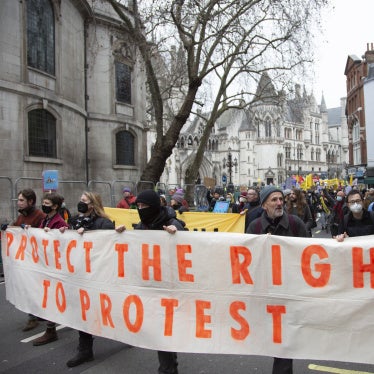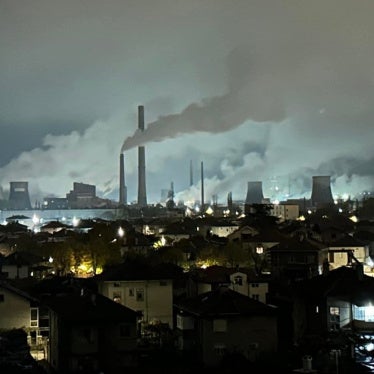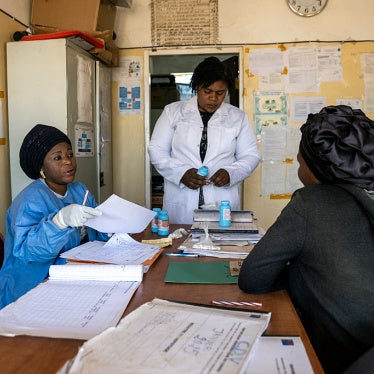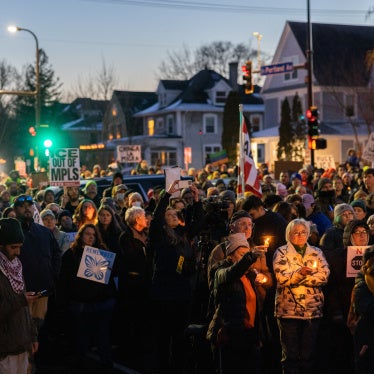(Moscow) – Riot police have used excessive force during the current demonstrations in Ukraine, based on accounts from witnesses. Witnesses described police attacks on people who were not using violence, including journalists and the elderly, during the protests in Kiev, Human Rights Watch said.
Human Rights Watch researchers in Kiev documented an incident on November 30, 2013, in which riot police beat and injured numerous peaceful protesters and another on December 1 in which riot police, in response to protester violence, beat people who were not acting violently, in at least several cases causing head injuries.
“Ukraine is going through serious civil unrest,” said Rachel Denber, deputy Europe and Central Asia director at Human Rights Watch. “No matter how difficult the situation becomes, police shouldn’t be beating people who pose no threat.”
Ukrainian authorities should conduct a thorough and impartial investigation into the incidents in which the riot police used excessive force in Kiev; make sure the police stop assaulting peaceful protesters; and hold those responsible to account, Human Rights Watch said. The authorities should ensure that the right to peaceful assembly is guaranteed, in compliance with Ukraine’s international obligations. Protesters should refrain from acts of violence.
Human Rights Watch said that police should use force only when strictly necessary, in a manner proportionate to the threat, and minimize the injury they cause.
Tens of thousands of people took to the streets in Kiev and other cities in Ukraine in the days following the government’s unexpected decision, announced on November 21, to suspend preparations for a European Union (EU)-Ukraine Association Agreement, a political and trade deal considered an important step toward Ukraine’s integration with the EU. Marches and rallies, largely peaceful, continued in Kiev and other Ukrainian cities for nine days, with little police interference.
Beatings at Independence Square, November 30
In the early morning of November 30, riot police violently dispersed several hundred peaceful protesters gathered at Independence Square in central Kiev. Later that day, Interior Minister Vitalii Zakharenko apologized for police use of excessive force and said that an investigation would be opened. Prime Minister Mykola Azarov also apologized for police actions on Independence Square, in parliament on December 3.
Demonstrators had maintained a round-the-clock gathering at Independence Square since November 21. Human Rights Watch interviewed 12 people who witnessed what happened there on November 30. They consistently said that at around 4 a.m., a man who appeared to be a municipal official in civilian clothing came to the square and asked the protesters to leave so that workers could put up the city’s Christmas tree. The protesters then formed a human chain around the monument at the center of the square.
In response, riot police moved in suddenly without warning and started hitting protesters with batons, pushing them off the monument and dragging them away. The entire operation lasted about 20 minutes. A video of the incident recorded by a witness and examined by Human Rights Watch shows riot police moving in on the protesters, striking them with batons, and kicking and hitting people who fell. Another video shows riot police chasing and grabbing people on adjacent streets and hitting those who had already fallen to the ground.
Igor, a protester who said he was at the square all night, told Human Rights Watch, “They mainly hit us on our legs and hands,” adding that the police also hit and kicked those who fell on the ground and chased people who were trying to run away. One policeman struck Igor on the back with a truncheon as he attempted to shield a young woman standing next to him.
Another protester, Lyubomyra, 63, told Human Rights Watch that a riot policeman struck her right wrist with his truncheon as she was trying to shield younger protesters. A doctor diagnosed a broken wrist.
A 49-year-old man told Human Rights Watch that a medic told him he had three broken ribs after a policeman hit him in the chest with a baton. He said that after police struck him, they dragged him into a nearby police bus and took him to a police station, where he had to wait for three hours before he was released and could get medical help.
In an official statement that afternoon, the Interior Ministry said that the city administration had requested assistance from the riot police because protesters were preventing the city from decorating the square for the winter holidays. The statement further alleged that once the riot police arrived at the square, the protesters started behaving aggressively, throwing trash, bottles of water, burning sticks, and other items at police.
One witness told Human Rights Watch that some people were throwing objects at police, but it was not clear who they were and whether they were among the protesters who had formed the human chain.
According to an Interior Ministry statement, police arrested 35 protesters. All were charged with misdemeanors and subsequently released, the statement said. In a separate statement, the ministry said that 12 law enforcement personnel were injured during the protest and that two criminal cases had been opened.
Dozens of people called an emergency assistance hotline set up via a social network on November 30, one of the volunteers involved in setting up the hotline told Human Rights Watch. Callers reported injuries, mostly cuts and bruises, allegedly from being hit with police batons. Several callers also asked for help locating missing relatives and friends, the activist said.
“Opening an investigation into police use of excessive force on November 30 is a positive step,” Denber said. “But it is crucial to hold those responsible for the attacks accountable, and for officials at the highest level to make clear that excessive use of force won’t be tolerated.”
Clashes on December 1
At about 4 p.m. on December 1, a series of violent clashes between police and protesters took place near the presidential administration building on Bankova Street. Dozens were injured. According to media reports, a group of activists commandeered a bulldozer and attempted to use it to break through a police cordon in front of the building, injuring several policemen. A group of activists then tried to break through the police chain using metal police barriers. Some activists also grabbed police shields and threw pieces of pavement at police. The police responded with teargas and smoke grenades and moved in on the protesters, hitting people with batons.
Witnesses told Human Rights Watch that the police beat many people, including some who were not behaving violently or who were trying run away from the clashes to adjacent streets.
Larisa, 33, told Human Rights Watch that she went with her parents and 27-year-old brother to Instytutska Street, adjacent to Bankova Street, at around 3 p.m. to join what was still a peaceful protest. She said that she was standing on Instytutska Street, about 600 meters from where the clashes were taking place, surrounded by peaceful protesters, when she suddenly heard explosions coming from the direction of the presidential administration building.
“All of a sudden, there were clouds of thick smoke and then I saw riot police running at people with their batons raised,” she told Human Rights Watch. “And then the police were hitting everyone in sight. I’ve never seen such brutality.” Larisa said she was looking for her brother when she was hit on the back with a police baton. She said she was soon surrounded by panicking people, many covered in blood. Some were on the ground, and some were trying to walk or run away.
Larisa said that her brother told her that he tripped, fell on the ground, and was hit on the head by a policeman. The same policeman hit Larisa’s mother and father as they were trying to help their son up. Larisa’s mother, 54, who was facing the policeman when he hit her, had to be taken by ambulance to a hospital. She had a concussion, a broken nose requiring surgery, multiple bruises on her face, and serious trauma to one of her eyes.
A policeman hit Larisa’s father, 60, on the head with a baton, causing a concussion, a medic told him.
“I was just looking for my family,” Larisa told Human Rights Watch. “And we did not do anything wrong.”
Mustafa Nayyem, a Ukrainian political journalist, showed Human Rights Watch a photo he had taken of a man with a bloodied face and head whom police continued hitting after he fell on the ground. Nayyem also said he saw another journalist who was bleeding heavily from a head wound being taken away in an ambulance.
“This level of violence by the police is shocking,” Denber said. “They needed to stop the violence and protect the presidential administration building, but that doesn’t justify beating people who weren’t violent and posed no threat.”
In a statement issued on December 2, Dunja Mijatović, the representative on freedom of the media for the Organization for Security and Cooperation in Europe, expressed concern about police violence against reporters at the demonstrations in Kiev and called on the Ukrainian authorities to investigate the attacks on journalists. Forty journalists have been “physically assaulted and severely injured” while covering the demonstrations in Kiev, the statement said.
Governments have the right and duty to stop violent attacks on police and public buildings, Human Rights Watch said. But in doing so, governments are obliged to respect basic human rights standards governing the use of force in police operations. These universal standards are embodied in the United Nations Basic Principles on the Use of Force and Firearms by Law Enforcement Officials, which state that “[w]henever the lawful use of force is unavoidable, law enforcement officials shall… exercise restraint in such use and act in proportion to the seriousness of the offense.”
Nine people were arrested in connection with clashes with police on Bankova Street on December 1, the Internal Affairs Ministry said in a statement.
According to statistics published by the Health Ministry, 248 people sought emergency medical assistance in Kiev between November 30 and December 2, 190 of them between 12 a.m. on December 1 and 6 a.m. on December 2. The Health Ministry said that 139 people had to be hospitalized, including 76 law enforcement personnel and 3 journalists.






